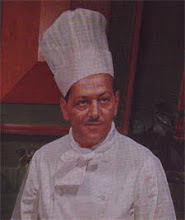Alcohol in my opinion makes for the finest of the aromatic sauces. Reduced rapidly or slowly as with casseroles the pan juices respond chemically with the wine creating new dimensions to flavour. Careful of using too much.
My advise is to always have a glass close by for excess and taste the alcohol regularly whilst cooking to insure that you have made the right choice.
Used subtly and combined with herbs the sauce chef can create some very satisfying flavours. For example, some Pernod or Ouzo added to a sauce using fennel is a superb combination for meat dishes, especially the braised pork chop.
Of course there is the Flambé, warm liqueur ignited and poured over the meal before serving. Alcohol should not be ignited until the pan juices are hot this will allow a good mix with out stirring. Shake the pan and spread the flame. This will burn off any excess butter or oil and will allow the flavour of the alcohol to penetrate. Again quantities are always a problem with the beginner so have that glass handy. Try to stick to recipes with measured amounts of alcohol before trying to go free hand.
Don’t buy cheap grog ever. Cheap alcohol is bad for the liver and gives you a headache. Buy good quality, always.
Alcohol in desserts, this is open to criticism on many levels. Many chefs believe alcohol to be un necessary in desserts. I disagree, what of the Tiramesù with no alcohol, or the Christmas cake with no rum. Galliano over Vanilla ice-cream with a shot of espresso. Any you get the message………..find reasons to use alcohol in desserts, everyone will be happier and healthier.


I have to agree with you about the Tirimisu, its nothing without the zest of alcohol. I think you mis-spelled Tirimisu.
ReplyDelete